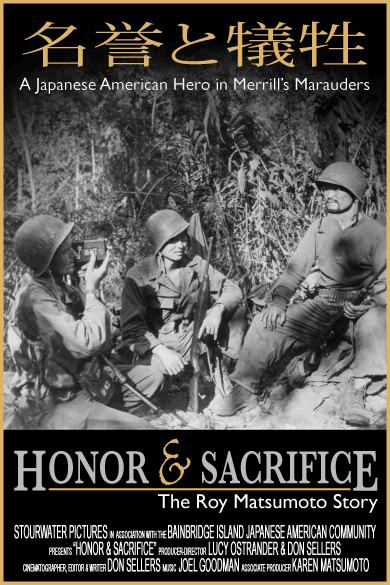Producers' Statement
From producer Don Sellers:
In 2008, my coproducer, Lucy Ostrander, and I were spellbound when Karen Matsumoto told us about her father, Roy, and his work with the U.S. Army's Military Intelligence Service with Merrill's Marauders in Burma during World War II. But we had no idea how extraordinary the story would turn out to be. Although I was familiar with Merrill's Marauders I only had a vague understanding of the heroic work of the Nisei who served as translators and interpreters of the Japanese language during that war. The story seemed fascinating and worthy of a film. Karen, who among her many talents is a gifted grant writer, volunteered to help find the necessary funding and the project began.
We received a grant from the Washington State Civil Liberties Public Education Program and made a 17-minute film that focused mainly on the role of Roy and the other Nisei in the Marauders. The finished film was well received but we were not satisfied that we had told the story in full and felt we needed to make a longer version. This was partly due to our research and discussions with Karen and others that revealed the deep complexity of the circumstances of many Japanese Americans during World War II. Roy's story, while unique, could illuminate the many ways Japanese Americans were deeply conflicted and dealt with that period. After losing their livelihoods and possessions, and being sent to remote prison camps, what should they do? How do they react to a government that put these American-born citizens and their relatives through that horror? How do they react to a war against their ancestral homeland, especially when many of them had close relatives still living in Japan? Different Nisei chose different paths and as Karen told us more, the more we thought Roy's story was too fantastic to believe. You couldn't make it up...and yet it was all true.
But crafting the film as a cohesive and compelling document posed numerous challenges. As I worked (and sometimes fought) with the material, an approach and structure to the film slowly evolved. I realized that to involve the audience emotionally, it would be best to tell the story from Karen's point of view. But even with that breakthrough we suffered from a lack of visuals. We had our interviews, the Matsumoto family photos, and some footage from the National Archives of the Marauders in Burma, but they weren't enough to cover the complexity of the story. By mid February, time was running out—we had promised our donors that we would have the film done on May 1, Roy's 100th birthday. As I began to despair that we would have to simplify and weaken the story to finish on time, Karen told us of a cousin who had recently discovered thousands of her grandfather's negatives in a house near Hiroshima. I had to see them.
When the photos, which included many stunning panoramas, arrived, we knew we had a unique treasure. But while providing the solution to our paucity of visuals, their power demanded a change in the narrative. We had to include the photographs as a character in the structure—so the film became an intricate weaving together of three major stories: Roy's narrative that exemplified the work of the MIS and Merrill's Marauders, the experiences of Roy's family in Japan, and the lives of Japanese American immigrants, richly depicted in Wakaji's photographs. It all came together in a magical way.
We want to thank the Bainbridge Island Japanese American Community for serving as our non-profit fiscal sponsor and all of the funders who made this longer film possible. They include the California Civil Liberties Public Education Program, the National Japanese American Historical Society, Humanities Washington, the Berkeley chapter of the JACL, the Northern California Time of Remembrance Committee, Merrill's Marauders Association, Merrill's Marauders Proud Descendants, Nisei Veterans Committee, Nisei Veterans Committee Foundation, Nisei Translators, Friends & Family of Nisei Veterans and Southwest Airlines. In addition, we want to thank all of our Kickstarter supporters for "kicking in" the remaining completion funds. But most importantly, we want to thank the Matsumoto family for trusting us with their story.




